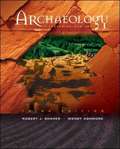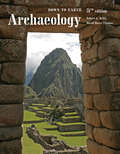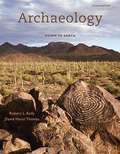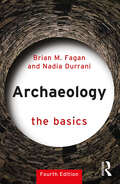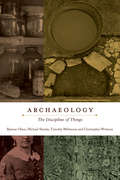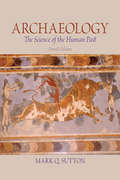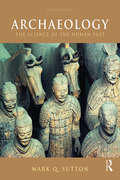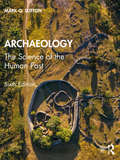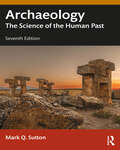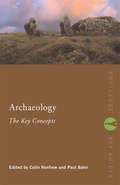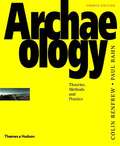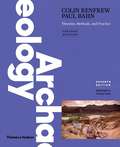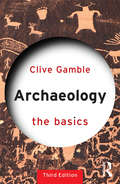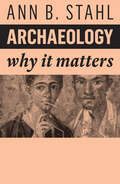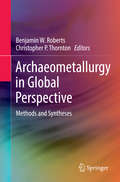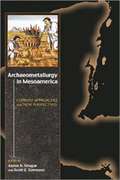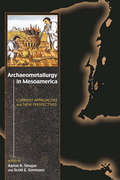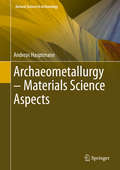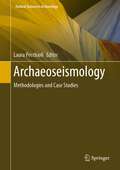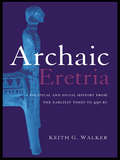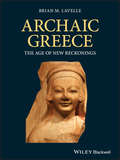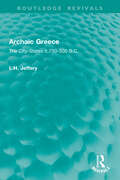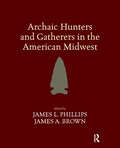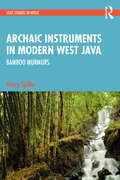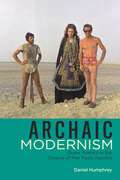- Table View
- List View
Archaeology: Discovering Our Past, Third Edition
by Robert J. Sharer Wendy AshmoreThis is the only textbook which is organized to follow the steps of the actual process of archaeological research in order to present the methods and theoretical frameworks of archaeology, from the planning and actual conduct of field research, to the different ways archaeological data is interpreted to produce an understanding of the past. It is also the only such textbook to give the reader a series of firsthand accounts of what its like to do archaeology, written by a variety of practicing archaeologists.
Archaeology: Down to Earth
by Robert L. Kelly David Hurst ThomasThis up-to-date, brief exploration of the field of archaeology pairs two of archaeology's most recognized names -- Robert L. Kelly of the University of Wyoming and David Hurst Thomas of the American Museum of Natural History. With their passionate, down-to-earth writing style, the authors emphasize doing fieldwork and truly engage students by offering extended, personalized examples throughout the text. Well-chosen examples from other sites around the world show how archaeologists have worked through actual problems in the field and in the lab. "What Does It Mean to Me?" boxes address issues about archaeology that relate to student's lives and demonstrate the value of understanding the past as well as the practical applications of archaeology today.
Archaeology: Down to Earth (4th edition)
by Robert L. Kelly David Hurst ThomasThis new brief edition pairs two of archaeology's most recognized names--David Hurst Thomas of the American Museum of Natural History and Robert L. Kelly of the University of Wyoming. The authors' passionate, down-to-earth introduction to archaeological method and theory makes the book ideal for all students, whether or not they intend to pursue a career in archaeology. Students will gain an immediate, concrete impression of what the practice of archaeology involves. The authors include well-chosen examples to show how archaeologists have worked through actual problems in the field and in the lab. After using this text, students will be better able to ask questions, solve problems, and discern "truth" from "fiction. " They will learn about the nature of archaeological data and how archaeologists do such things as archaeological survey and excavation. They will also develop their sense of scientific logic and gain a better understanding of career opportunities available to archaeologists. This edition is enhanced with a new full-color design that improves the visual presentation and enables students to more clearly see the key points of an image. A rich array of supplemental resources includes a new companion website as well as the option to use the DOING FIELDWORK: ARCHAEOLOGICAL DEMONSTRATIONS CD-ROM, Version 2. 0, also developed by the authors.
Archaeology: The Basics (The Basics)
by Brian M. Fagan Nadia DurraniArchaeology: The Basics, rewritten for this fourth edition, is a short, engaging book that takes the reader on a journey through the fascinating world of archaeology and archaeologists. Written in a non-technical style by two experienced archaeologists and writers about the past, the book begins by introducing archaeology as a unique way of studying the entire span of the human past from our origins some six million years ago to today. The authors stress that archaeology is a global study of human biological and cultural diversity. After a brief look at early archaeological discoveries, they introduce today’s multidisciplinary archaeology. Then they go on to describe the archaeological record, the archives of the past and the importance of contexts of time and space. How do we find archaeological sites and how do we explore them? Two chapters laced with examples examine these questions. Later chapters describe ancient technologies and how we study them, and the all-important subject of changing ancient environments and climate change. Zooarchaeology, flotation methods, and other ways of reconstructing ancient diet and subsistence lead us into the study of changing settlement patterns across the landscape. Next, they visit the people of the past, either as individuals or groups, calling on bioarchaeology to assist them. Two chapters discuss ancient culture change and the remarkable diversity of ancient societies, and they are followed by an exploration of the spiritual realm, the exploration of the intangible. The final chapter looks at the importance of archaeology in today’s world. Rich in numerous examples and contemporary thinking about archaeology, this book tries to answer an important question: What does archaeology tell us about ourselves? Archaeology: The Basics is essential reading for all those beginning to study archaeology and anyone who has ever questioned the past.
Archaeology: The Discipline of Things
by Michael Shanks Christopher Witmore Timothy Webmoor Bjørnar OlsenArchaeology has always been marked by its particular care, obligation, and loyalty to things. While archaeologists may not share similar perspectives or practices, they find common ground in their concern for objects monumental and mundane. This book considers the myriad ways that archaeologists engage with things in order to craft stories, both big and small, concerning our relations with materials and the nature of the past. Literally the "science of old things," archaeology does not discover the past as it was but must work with what remains. Such work involves the tangible mediation of past and present, of people and their cultural fabric, for things cannot be separated from society. Things are us. This book does not set forth a sweeping new theory. It does not seek to transform the discipline of archaeology. Rather, it aims to understand precisely what archaeologists do and to urge practitioners toward a renewed focus on and care for things.
Archaeology: The Science of the Human Past
by Mark Q SuttonIlluminating the world of archaeology. Archaeology conveys the excitement of archaeological discovery and explains how archaeologists think as they scientifically find, analyze, and interpret evidence. The main objective of this text is to provide an introduction to the broad and fascinating world of archaeology from the scientific perspective. Discussions on the theoretical aspects of archaeology, as well as the practical applications of what is learned about the past, have been updated and expanded upon in this fourth edition. Learning GoalsUpon completing this book, readers will be able to: Discuss the theoretical aspects of archaeology. Apply what has been learned about the past. Identify the various perspectives archaeologists have.
Archaeology: The Science of the Human Past
by Mark Q SuttonArchaeology: The Science of the Human Past provides an introduction to the broad and fascinating world of archaeology from the scientific perspective. Conveying the exhilaration of archaeological work, it explores the ways archaeologists analyse and interpret evidence. Varying perspectives are considered to provide holistic coverage of archaeological techniques and methods and show how the complexity of the past can be captured by the empirical science of archaeology. The Fifth Edition has been updated and revised to include the latest archaeological approaches and the impact developments in archaeological science have made in recent years. The chapter on bioarchaeology has been completely rewritten to reflect these developments. Archaeology: An Introduction will allow students to understand the theoretical and scientific aspects of archaeology and how various archaeological perspectives and techniques help us understand how and what we know about the past.
Archaeology: The Science of the Human Past
by Mark Q. SuttonArchaeology: The Science of the Human Past provides students with a thorough understanding of what archaeology is and how it operates and familiarizes them with fundamental archaeological concepts and methods. This volume introduces the basic components of archaeology, including sites, artifacts, ecofacts, remote sensing, and excavation. It discusses how archaeologists obtain and classify information and how they analyze this information to formulate and test models of what happened in the past. Cultural resource management and the laws and regulations that deal with archaeology around the world are described. Archaeology is placed in the context of contemporary issues, from environmental problems to issues affecting Indigenous populations. The sixth edition has been updated and simplified to create a more streamlined volume to meet the needs of the students and teachers for whom it is designed, reflecting the latest developments in archaeological techniques and approaches. Allowing students to understand the theoretical and scientific aspects of archaeology and how various archaeological perspectives and techniques help us understand how and what we know about the past, Archaeology: The Science of the Human Past is an ideal introduction to archaeology.
Archaeology: The Science of the Human Past
by Mark Q. SuttonArchaeology: The Science of the Human Past introduces students to the wide-ranging and fascinating world of archaeology and provides them with a comprehensive understanding of fundamental archaeological concepts and methods.The seventh edition keeps pace with the developments in archaeological science with up-to-date information on dating, artifact analyses, and remote sensing. Theoretical developments in power, gender, and cognition are also included. Introducing the key components of archaeology, including sites, artifacts, ecofacts, remote sensing, and excavation, it discusses the ways archaeologists obtain, analyze, and interpret evidence. Varying perspectives are considered to provide holistic coverage of how archaeological techniques and methods are used to formulate and test models of what happened in the past. Cultural resource management and the laws and regulations that deal with archaeology around the world are described. Archaeology is placed in the context of current topics, from environmental problems to issues affecting Indigenous populations.Archaeology: The Science of the Human Past remains an ideal introduction to archaeology by offering students a broad and clear understanding of the theoretical and scientific aspects of archaeology and how various archaeological perspectives and techniques help us comprehend not just the past but the contemporary world as well.
Archaeology: Theories, Methods, And Practice (Routledge Key Guides)
by Colin Renfrew Paul BahnFrom two of the best-known archaeological writers in the trade, this outstanding resource provides a thorough survey of the key ideas in archaeology, and how they impact on archaeological thinking and method. Clearly written, and easy to follow, Archaeology: The Key Concepts collates entries written specifically by field specialists, and each entry offers a definition of the term, its origins and development, and all the major figures involved in the area. The entries include: thinking about landscape archaeology of cult and religion cultural evolution concepts of time urban societies the antiquity of humankind archaeology of gender feminist archaeology experimental archaeology multiregional evolution. With guides to further reading, extensive cross-referencing, and accessibly written for even beginner students, this book is a superb guide for anyone studying, teaching, or with any interest in this fascinating subject.
Archaeology: Theories, Methods, and Practice (4th Edition)
by Colin Renfrew Paul BahnA textbook on archaeology: its history; the variety of evidence; survey and excavation of sites and features; dating methods; social, environmental and cognitive archaeology; 5 case studies, and the archaeology of people.
Archaeology: Theories, Methods, and Practice (Seventh Edition)
by Colin Renfrew Paul BahnSince its first edition, Renfrew and Bahn's Archaeology: Theories, Methods, and Practice has been the leading academic source on what archaeologists do and how they do it. This indispensable book is a comprehensive introduction to archaeology in the field, the laboratory, and the library. Archaeology is organized around the key questions that archaeologists ask about the past and details the practical and theoretical ways in which answers to those questions are sought. The seventh edition has been thoroughly revised and updated to include the newest developments in the subject and the latest discoveries, and is newly designed with additional box features and extensive drawings, charts, and photographs, all in full color.
Archaeology: Trajectories To Early States (The Basics)
by Clive GambleNow in an updated third edition, Archaeology: The Basics provides a straightforward and engaging introduction to the world of Archaeology. This book answers key questions about how and why we practice archaeology and examines the theories and themes underpinning the subject. Fully updated, this new edition includes a wide range of examples and new material on key growth areas including:* Evolutionary approaches in current archaeology* The archaeology of landscape and place* The impact and value of archaeology* Conflict archaeology and the politics of the pastWith 12 new illustrations, four new boxes and additional case studies this text is essential reading for all those beginning to study archaeology and anyone who has ever questioned the past.
Archaeology: Why It Matters (Why It Matters #1)
by Ann B. StahlHistory lies beneath our feet and in the landscapes around us. In contrast to the history that comes from studying texts, archaeology is the study of history through objects, monuments, and other traces of past lives: history that extends beyond the earliest writings into the deep past, revealing the varied pathways that led to the present, and the challenges – often similar to those we face today – that confronted our ancestors. Ann Stahl argues that archaeology is unique in its focus on the everyday lives of all peoples in all places and times. From ancient temples to humble homes, archaeologists piece together worlds that would otherwise be lost: knowledge that shows us how routine actions have shaped societies, how and why societies have changed in light of environment, politics, and culture – and perhaps what the future holds for our societies too. Using compelling examples from a storied international career, Stahl provides the perfect summary of why archaeology is both a vitally important and enjoyable subject to study.
Archaeometallurgy in Global Perspective: Methods and Syntheses
by Benjamin W. Roberts Christopher P. ThorntonThe study of ancient metals in their social and cultural contexts has been a topic of considerable interest in archaeology and ancient history for decades, partly due to the modern dependence on technology and man-made materials. The formal study of Archaeometallurgy began in the 1970s-1980s, and has seen a recent growth in techniques, data, and theoretical movements. This comprehensive sourcebook on Archaeometallurgy provides an overview of earlier research as well as a review of modern techniques, written in an approachable way. Covering an extensive range of archaeological time-periods and regions, this volume will be a valuable resource for those studying archaeology worldwide. It provides a clear, straightforward look at the available methodologies, including: * Smelting processes * Slag analysis * Technical Ceramics * Archaeology of Mining and Field Survey * Ethnoarchaeology * Chemical Analysis and Provenance Studies * Conservation Studies With chapters focused on most geographic regions of Archaeometallurgical inquiry, researchers will find practical applications for metallurgical techniques in any area of their study. Ben Roberts is a specialist in the early metallurgy and later prehistoric archaeology of Europe. He was the Curator of the European Copper and Bronze Age collections at the British Museum between 2007 and 2012 and is now a Lecturer in Prehistoric Europe in the Departm ent of Archaeology at the Durham University, UK. Chris Thornton is a specialist in the ancient metallurgy of the Middle East, combining anthropological theory with archaeometrical analysis to understand the development and diffusion of metallurgical technologies throughout Eurasia. He is currently a Consulting Scholar of the University of Pennsylvania Museum, where he received his PhD in 2009, and the Lead Program Officer of research grants at the National Geographic Society.
Archaeometallurgy in Mesoamerica
by Aaron N. Shugar Scott E. SimmonsPresenting the latest in archaeometallurgical research in a Mesoamerican context,Archaeometallurgy in Mesoamericabrings together up-to-date research from the most notable scholars in the field. These contributors analyze data from a variety of sites, examining current approaches to the study of archaeometallurgy in the region as well as new perspectives on the significance metallurgy and metal objects had in the lives of its ancient peoples. The chapters are organized following the cyclical nature of metals--beginning with extracting and mining ore, moving to smelting and casting of finished objects, and ending with recycling and deterioration back to the original state once the object is no longer in use. Data obtained from archaeological investigations, ethnohistoric sources, ethnographic studies, along with materials science analyses, are brought to bear on questions related to the integration of metallurgy into local and regional economies, the sacred connotations of copper objects, metallurgy as specialized crafting, and the nature of mining, alloy technology, and metal fabrication.
Archaeometallurgy in Mesoamerica: Current Approaches and New Perspectives
by Aaron N. Shugar Scott E. SimmonsPresenting the latest in archaeometallurgical research in a Mesoamerican context, Archaeometallurgy in Mesoamerica brings together up-to-date research from the most notable scholars in the field. These contributors analyze data from a variety of sites, examining current approaches to the study of archaeometallurgy in the region as well as new perspectives on the significance metallurgy and metal objects had in the lives of its ancient peoples. The chapters are organized following the cyclical nature of metals--beginning with extracting and mining ore, moving to smelting and casting of finished objects, and ending with recycling and deterioration back to the original state once the object is no longer in use. Data obtained from archaeological investigations, ethnohistoric sources, ethnographic studies, along with materials science analyses, are brought to bear on questions related to the integration of metallurgy into local and regional economies, the sacred connotations of copper objects, metallurgy as specialized crafting, and the nature of mining, alloy technology, and metal fabrication.
Archaeometallurgy – Materials Science Aspects (Natural Science in Archaeology)
by Andreas HauptmannThis book successfully connects archaeology and archaeometallurgy with geoscience and metallurgy. It addresses topics concerning ore deposits, archaeological field evidence of early metal production, and basic chemical-physical principles, as well as experimental ethnographic works on a low handicraft base and artisanal metal production to help readers better understand what happened in antiquity. The book is chiefly intended for scholars and students engaged in interdisciplinary work.
Archaeoseismology: Methodologies and Case Studies (Natural Science in Archaeology)
by Laura PecchioliArchaeoseismic research provides data and information on past earthquakes but is limited by the lack of ongoing discussions about methodology. This volume is an interdisciplinary approach including archaeologists, geologists, geophysicists, seismologists, engineers, and architects from different countries to present a comprehensive recording and interpretation of ancient natural disasters on some case studies. The publication is an introduction to various aspects of the field of archaeoseismology for the knowledge of past seismicity, the reconstruction of the chronological history of a place, the interpretation and identification of seismic effects using different methods, etc. The collection provides an overview of research into archaeoseismology, making new contributions through innovative ideas on various topics. The publication can be an illustrative introduction to better understand the complexity of interpreting seismic effects on ancient and modern masonries, particularly for students with an open mind.
Archaic Eretria: A Political and Social History from the Earliest Times to 490 BC
by Keith G. WalkerThis book presents for the first time a history of Eretria during the Archaic Era, the city's most notable period of political importance and Keith Walker examines all the major elements of the city's success. One of the key factors explored is Eretria's role as a pioneer coloniser in both the Levant and the West - its early Aegaen 'island empire' anticipates that of Athens by more than a century, and Eretrian shipping and trade was similarly widespread. Eretria's major, indeed dominant, role in the events of central Greece in the last half of the sixth century, and in the events of the Ionian Revolt to 490 is clearly demonstrated, and the tyranny of Diagoras (c.538-509), perhaps the golden age of the city, is fully examined. Full documentation of literary, epigraphic and archaeological sources (most of which has previously been inaccessible to an English speaking-audience) is provided, creating a fascinating history and valuable resource for the Greek historian.
Archaic Greece: The Age of New Reckonings
by Brian M. LavelleAn introductory guide to the Archaic period in ancient Greece—the people, their society, and their culture. Excerpts from literary and other texts give voice to the interests, concerns, and emotions of the Archaic Greeks themselves. This book provides a brief but comprehensive introduction to the society and culture of the Archaic period in the Greek world from c. 750 to c. 480 BCE. It focuses on the persistent and often-conflicting themes, topics, and controversies of the Archaic Age (e.g., elite and non-elite, religion and science, tradition and humanism). It seeks to lead the reader to a broader and deeper understanding of the period by placing themes and topics in a mutually supportive contextual network that will underscore their significance. Archaic Greece: The Age of New Reckonings begins with a chapter on how sources for the period are evaluated and deployed, and goes on to offer a concise yet thorough historical overview of the Archaic period. Subsequent chapters cover polis and politics; war and violence; religion; science; philosophy; art; literature; festivals and games; social forces, values, and behaviors; and gender and sex. The book: Offers a novel approach to a very significant period that foregrounds literary evidence and the words voiced by Archaic Greeks, combining scholarship with readability; Conceptualizes Archaic Greek culture and society by focusing substantially on topics that supplement the history of the period; Combines diverse elements of society and culture, including religion, art, literature, games and festivals, gender, sexuality, and politics in order to develop a unique picture of Greece during the Archaic period; Includes a summarizing essay that draws chapters together, emphasizing the implications of their topics and themes. Archaic Greece: The Age of New Reckonings should appeal to college-level instructors as a book to assign to students enrolled in courses involving Archaic Greece and to others interested in this intriguing and pivotal period in ancient Greece.
Archaic Greece: The City-States c.700–500 B.C. (Routledge Revivals)
by L.H. JefferyArchaic Greece (1976) describes the typical polis, and considers in turn each city-state in mainland Greece, the Aegean and the coast of Asia Minor. In detailing its history and local culture, as well as events which had great impact on the period – the reforms of Solon, the expulsion of tyrants – the book shows how each contributed to the structure of Greek society as a whole.
Archaic Hunters and Gatherers in the American Midwest
by James L. Phillips, James A. BrownThis volume reports on a series of multidisciplinary projects involving the Archaic period of the American Midwest. A period of innovation and technical achievement, the articles focus on changes in environmental, social, and economic factors operating in this period, and the adaptation of the hunter gatherer peoples living at this time.
Archaic Instruments in Modern West Java: Bamboo Murmurs (SOAS Studies in Music)
by Henry SpillerArchaic Instruments in Modern West Java: Bamboo Murmurs explores how current residents of Bandung, Indonesia, have (re-)adopted bamboo musical instruments to forge meaningful bridges between their past and present—between traditional and modern values. Although it focuses specifically on Bandung, the cosmopolitan capital city of West Java, the book grapples with ongoing issues of global significance, including musical environmentalism, heavy metal music, the effects of first-world hegemonies on developing countries, and cultural “authenticity.” Bamboo music's association with the Sundanese landscape, old agricultural ceremonies, and participatory music making, as well as its adaptability to modern society, make it a fertile site for an ecomusicological study.
Archaic Modernism: Queer Poetics in the Cinema of Pier Paolo Pasolini (Queer Screens)
by Daniel HumphreyIn Archaic Modernism, Daniel Humphrey offers the first book-length, English-language examination of three adaptations of Greek tragedy produced by the gay and Marxist Italian filmmaker Pier Paolo Pasolini: Oedipus Rex (1967), Medea (1969), and Notes Towards an African Orestes (1970/1973). Considering Pasolini’s own theories of a "Cinema of Poetry" alongside Jacques Derrida’s concept of écriture, as well as more recent scholarship by queer theory scholars advocating for an antirelational and antisocial subjectivity, Humphrey maintains that Pasolini’s Greek tragedy films exemplify a paradoxical sense of "archaic modernism" that is at the very heart of the filmmaker’s project. More daringly, he contends that they ultimately reveal the queer roots of Western civilization’s formative texts. Archaic Modernism is comprised of three chapters. Chapter 1 focuses on Oedipus Rex, assessing both the filmic language employed and the deeply queer mythological source material that haunts the tragedy even as it remains largely at a subtextual yet palpable level. Chapter 2 extends and deepens the concept of queer fate and queer negativity in a scene-by-scene analysis of Medea. Chapter 3 looks at the most obscure of Pasolini’s feature length films, Notes Towards an African Orestes, a film long misunderstood as an unwitting failure, but which could perhaps best be understood as a deliberate, sacrificial act on the filmmaker’s part. Considering the film as the third in an informal, maybe unconscious, trilogy, Humphrey concludes his monograph by arguing that this "trilogy of myth" can best be understood as a deconstruction, gradually more and more severe, of three of the most important origin tales of Western civilization. Archaic Modernism makes the case that these three films are as essential as those Pasolini films more often studied in the Anglophone world: Mamma Roma, The Gospel According to Matthew, Teorema, The Trilogy of Life, and Salò, and that they are of continuing, perhaps even increasing, value today. This book is of specific interest to scholars, students, and researchers of film and queer studies.
